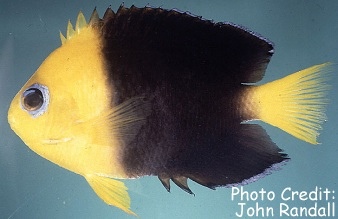
By Bob Goemans

Likely Reef Tank Suitable
Likely Fish-Only Tank Suitable
Range: Eastern Indian Ocean: Cocos-Keeling Islands and at Christmas Island.
Size: 3.5 inches (9 cm)
Natural Environment: Inhabits coral and rubble areas on steep outer slopes in solitary or small groups of four to five individuals and found at a wide range of depths, from 15 to below 200 feet (5 – 65 m).
General Husbandry: This beautiful dwarf angelfish is ‘very’ rarely seen in the hobby, and when so, ‘extremely’ expensive! Its front body half is yellow, the rear half and its dorsal and anal fins are a deep purplish blue, with the edges of those fins a bright blue, and a tail that is bright yellow. Its also has a brilliant blue ring circling the back portion of the eye.
An excellent browser of microalgae and detritus and as with most other species in this genus, a twice daily feeding consisting of a wide variety of frozen foods including fortified brine shrimp, mysis, and flake food, especially Spirulina should suffice nicely. Nevertheless, since this is a rarely collected species, and travels a far distance to an owner’s aquarium, recommend when first introduced into the aquarium, preferable a well-established reef or fish-only aquarium where it can browse rock surfaces and crevices for various kinds of nutritional foodstuffs, it be offered several, three to four daily feedings, so as to quickly become acclimated to its surroundings.
Can be quite shy when first entering the aquarium, and will hide in caves and crevices. But as time passes, will become more outgoing and begin to establish its territory. Yet keep in mind they are not suited for small nano style aquariums, as they will not only become quite aggressive in small aquariums, they will, without numerous feedings per day, be able to find enough food to be maintained long-term. Also keep in mind only one species from this dwarf angelfish genus should be in the aquarium, as they will develop aggression to other dwarf angelfish.
Taxonomy:
Order: Perciformes
Suborder: Percoidei
Family: Pomacanthidae
Genus: Centropyge
FYI: All Centropyge species start life as unsexed individuals, but begin their adult life as females. Then, the larger or more dominant individual within small groups will change sex within a few days to a couple of weeks and become a male. Knowing that size is the main difference between the sexes, and not so much its coloration, all one needs to do is place a small and larger specimen together. Within approximately sixty days one of the two fish will have physically changed sex to accommodate the other. A reversal of this sex change is possible if the need arises, but that requires much more time, e.g., weeks to months.
Keep in mind all angels have cheekspines at the edge of their gill cover; therefore use caution when handling and also avoid using a net to capture it, as it may become stuck or tangled in the net and become damaged when removed.
Experience Level: Intermediate
Temperament: Semi-aggressive
Diet: Omnivore
Acclimation Time: 30 minutes+
Aquarium Environment: Reef or fish-only aquarium
Reef Safe: With caution – has a tendency to nip clam mantles, sea anemones, large–polyped stony (LPS) corals and some soft corals such as zoanthids, especially so when underfed.
Minimum Tank Size: 50 gallons
Temperature Range: 72 - 79°F (22 – 26°C).
Specific Gravity: 1.020-1.027
pH: 8.0 - 8.5
